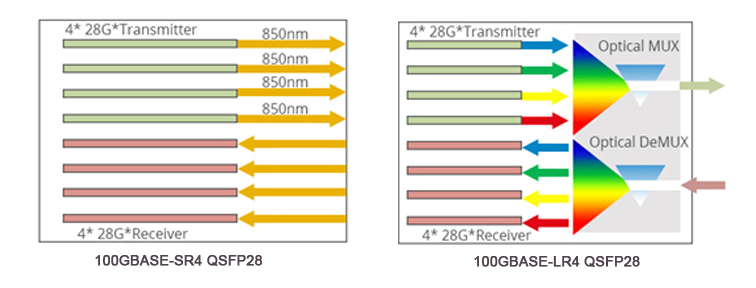May 16, 2016
As bandwidth demands continue to grow, network service providers are looking at even higher networks of 100 Gigabit Ethernet (100GbE) to accommodate the constant traffic surge. 100 GbE is a group of computer networking technologies for transmitting Ethernet frames at rates of 100 gigabits per second (100Gbit/s). With the growing technology, the business case for 100 Gigabit Ethernet is becoming inescapably compelling. The 100G market has risen. QSFP28, as a new form factor, becomes more and more popular in the 100G transceiver market. What is QSFP28 transceiver? Why QSFP28 transceivers are popular in 100GbE networks? This post will give a brief introduction to QSFP28 transceiver in 100GbE networks.
QSFP28 transceiver is designed for 100G speeds and using the 4×25 wiring specification. The QSFP28 is the exact same footprint as the 40G QSFP+. The "Q" is for "Quad"; just as the 40G QSFP+ is implemented using four 10-Gbps lanes, the 100G QSFP28 is implemented with four 25-Gbps lanes. In all QSFP versions, both the electrical lanes and the optical lanes operate at the same speed, eliminating the costly gearbox found in CFP, CFP2, and the CPAK. The QSFP28 module has an upgraded electrical interface to support signaling up to 28 Gbps signals, yet keeps all of the physical dimensions of its predecessor.
Two basic versions of QSFP28 transceivers are 100GBASE-SR4 QSFP28 transceiver and 100GBASE-LR4 QSFP28 transceiver, which are respectively used for multimode fiber (MMF) and single-mode fiber (SMF) 100G applications. The following pictire shows working principles of these two type of QSFP28 transceivers.

QSFP28 transceiver makes deploying 100GbE networks easy as 10GbE networks, having a strong ability to increase density, decrease power consumption, and decrease price per bit. It becomes a universal preferred data center form factor for several reasons.
1. QSFP28 transceiver increases front-panel density over QSFP+ transceiver. It has the same form factor and the maximum number of ports with QSFP+ transceiver, but the lane speeds are increased from 10 Gbps to 25 Gbps. Thus, QSFP28 transceiver increases front-panel density over QSFP+ transceiver. And the increase in panel density is even more dramatic when compared to some of the other 100 Gbps form factors, 450% versus the CFP2 and 360% versus the CPAK.
2. There are limitations of other versions of 100G transceivers. For example, in the first generation of 100GbE switches and routers, the smaller CXP form factor was used for cabling and the CFP or CFP2 was used for transceivers. This forced huge equipment design sacrifices. A switch with CXP ports couldn't be used in a data center with single-mode fiber (SMF). A router using CFP2 or CPAK ports had bandwidth limited by the 8-10 ports that could fit on the front panel.
3. With QSFP28 transceivers, a one rack-unit switch can accommodate up to 36 QSFP ports. Many more varieties of transceivers and cables can plug into these ports. The cables can be either copper direct attach cables (DACs) or active optical cables (AOCs).
4. QSFP28 transceivers can use either VCSELs (useful for shorter distances on MMF) or silicon photonics (for longer distances on SMF). Silicon photonics enables QSFP28 transceivers to support any data center up to 10 kilometers, and provide a high degree of integration. Silicon photonics is low power; even WDM (wavelength division multiplexing) designs can fit within the 3.5W maximum of QSFP.
At present market, the form factors of 100G transceiver module include CXP, CFP, CFP2, CPAK, CFP4 and QSFP28. Among them, QSFP28 demonstrates its great superiority. It increases density and decreases power and price per bit. QSFP28 transceiver has a great market prospect. And the coming generations of high-bandwidth switches, routers, and adapters will all feature QSFP28 ports to better adapt the 100G (or beyond) network demands. Fiberstore provides you with all kinds of QSFP28 optics with high quality. You can buy from us with confidence.
Posted by: jowang at
03:56 AM
| No Comments
| Add Comment
Post contains 648 words, total size 5 kb.
35 queries taking 0.2157 seconds, 70 records returned.
Powered by Minx 1.1.6c-pink.









